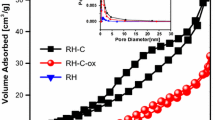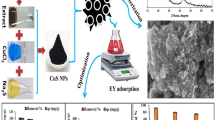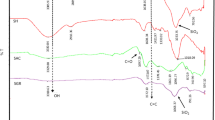Abstract
A novel adsorbent design method, based on organic surface modification and carbonization at 350–500 °C, of sepiolite, was used to prepare carbon@sepiolite composites which were used for hazardous malachite green dye removal from water. Prior to their use as adsorbent, the structure and the morphology of the carbon@sepiolite composites were assessed by various methods, such as Fourier transform infrared (FTIR) spectroscopy, scanning (SEM) and transmission (TEM) electron microscopy, energy-dispersive analysis of X-rays (EDAX), and N2 adsorption/desorption isotherms (BET method). The designed adsorbents showed good adsorption properties for MG molecules, reaching a maximum dye adsorbed amount of 1198.67 mg/g at 25 °C for the carbon@sepiolite composites calcinated at 500 °C. Further, the kinetics and the equilibrium adsorption isotherms of the MG molecules from water onto the sepiolite-based composites were well fitted by, respectively, the pseudo-second-order model (R2 = 0.98) and the Langmuir isotherm (R2 = 0.94) models, indicating that the MG molecules were homogenously adsorbed and formed a monolayer on the organically modified sepiolite surface. Moreover, the values of the thermodynamic parameters, such as ∆G, ∆H, and ∆S related to the adsorption process, indicated that the adsorption reaction was spontaneous, feasible, and endothermic. In the overall, the present work offers facile ways for the design of organically modified sepiolite which can be used at large scale as adsorbents for waste recycling.











Similar content being viewed by others
Data availability
All data are included within the text.
References
Akbar, M., & Irohara, T. (2018). Scheduling for sustainable manufacturing: A review. Journal of Cleaner Production, 205, 866–883. https://doi.org/10.1016/j.jclepro.2018.09.100
Akhouairi, S., Ouachtak, H., Addi, A. A., Jada, A., & Douch, J. (2019). Natural sawdust as adsorbent for the Eriochrome black T dye removal from aqueous solution. Water, Air, & Soil Pollution, 230, 181. https://doi.org/10.1007/s11270-019-4234-6
Alakhras, F., Alhajri, E., Haounati, R., Ouachtak, H., Addi, A. A., & Saleh, T. A. (2020). A comparative study of photocatalytic degradation of Rhodamine B using natural-based zeolite composites. Surfaces and Interfaces, 20, 100611. https://doi.org/10.1016/j.surfin.2020.100611
Altinişik, A., Gür, E., & Seki, Y. (2010). A natural sorbent, Luffa cylindrica for the removal of a model basic dye. Journal of Hazardous Materials, 179, 658–664. https://doi.org/10.1016/j.jhazmat.2010.03.053
Atkin, P. W. (1990). Physical chemistry (4th ed.). Oxford University Press.
Blanchard, G., Maunaye, M., & Martin, G. (1984). Removal of heavy metals from waters by means of natural zeolites. Water Research, 18, 1501–1507. https://doi.org/10.1016/0043-1354(84)90124-6
Bouaziz, F., Koubaa, M., Kallel, F., Ghorbel, R. E., & Chaabouni, S. E. (2017). Adsorptive removal of malachite green from aqueous solutions by almond gum: Kinetic study and equilibrium isotherms. International Journal of Biological Macromolecules, 105, 56–65. https://doi.org/10.1016/j.ijbiomac.2017.06.106
Boukoussa, B., Mokhtar, A., El Guerdaoui, A., Hachemaoui, M., Ouachtak, H., Abdelkrim, S., Addi, A. A., Babou, S., Boudina, B., Bengueddach, A., & Hamacha, R. (2021). Adsorption behavior of cationic dye on mesoporous silica SBA-15 carried by calcium alginate beads: experimental and molecular dynamics study. Journal of Molecular Liquids, 333, 115976. https://doi.org/10.1016/j.molliq.2021.115976
Bulgariu, L., Escudero, L. B., Bello, O. S., Iqbal, M., Nisar, J., Adegoke, K. A., Alakhras, F., Kornaros, M., & Anastopoulos, I. (2019). The utilization of leaf-based adsorbents for dyes removal: A review. Journal of Molecular Liquids, 276, 728–747. https://doi.org/10.1016/j.molliq.2018.12.001
Chowdhury, S., Mishra, R., Saha, P., & Kushwaha, P. (2011). Adsorption thermodynamics, kinetics and isosteric heat of adsorption of malachite green onto chemically modified rice husk. Desalination, 265, 159–168. https://doi.org/10.1016/j.desal.2010.07.047
Daneshvar, N., Ayazloo, M., Khataee, A. R., & Pourhassan, M. (2007). Biological decolorization of dye solution containing Malachite Green by microalgae Cosmarium sp. Bioresource Technology, 98, 1176–1182. https://doi.org/10.1016/j.biortech.2006.05.025
de Souza, T. N. V., de Carvalho, S. M. L., Vieira, M. G. A., da Silva, M. G. C., & do Socorro Barros Brasil, D. (2018). Adsorption of basic dyes onto activated carbon: experimental and theoretical investigation of chemical reactivity of basic dyes using DFT-based descriptors. Applied Surface Science, 448, 662–670. https://doi.org/10.1016/j.apsusc.2018.04.087
El Haouti, R., Ouachtak, H., El Guerdaoui, A., Amedlous, A., Amaterz, E., Haounati, R., Addi, A. A., Akbal, F., El Alem, N., & Taha, M. L. (2019). Cationic dyes adsorption by Na-Montmorillonite nano clay: experimental study combined with a theoretical investigation using DFT-based descriptors and molecular dynamics simulations. Journal of Molecular Liquids, 290, 111139. https://doi.org/10.1016/j.molliq.2019.111139
Freundlich, H. (1907). Über die Adsorption in Lösungen. Zeitschrift Für Phys. Chemie, 57U, 385–470. https://doi.org/10.1515/zpch-1907-5723
Gusmão, K. A. G., Gurgel, L. V. A., Melo, T. M. S., & Gil, L. F. (2013). Adsorption studies of methylene blue and gentian violet on sugarcane bagasse modified with EDTA dianhydride (EDTAD) in aqueous solutions: Kinetic and equilibrium aspects. Journal of Environmental Management, 118, 135–143. https://doi.org/10.1016/j.jenvman.2013.01.017
Haounati, R., El Guerdaoui, A., Ouachtak, H., El Haouti, R., Bouddouch, A., Hafid, N., Bakiz, B., Santos, D. M. F., LabdTaha, M., Jada, A., & AitAddi, A. (2021). Design of direct Z-scheme superb magnetic nanocomposite photocatalyst Fe3O4/Ag3PO4@Sep for hazardous dye degradation. Separation and Purification Technology, 277, 119399. https://doi.org/10.1016/j.seppur.2021.119399
Haounati, R., Ouachtak, H., El Haouti, R., Akhouairi, S., Largo, F., Akbal, F., Benlhachemi, A., Jada, A., & Addi, A. A. (2021c). Elaboration and properties of a new SDS/CTAB@Montmorillonite organoclay composite as a superb adsorbent for the removal of malachite green from aqueous solutions. Separation and Purification Technology, 255, 117335. https://doi.org/10.1016/j.seppur.2020.117335
Haounati, R., Alakhras, F., Ouachtak, H., Saleh, T. A., Al-Mazaideh, G., Alhajri, E., Jada, A., Hafid, N., & Addi, A. A. (2022). Synthesized of zeolite@Ag2O nanocomposite as superb stability photocatalysis toward hazardous rhodamine B dye from water. Arabian Journal for Science and Engineering. https://doi.org/10.1007/s13369-022-06899-y
Ho, Y. S., & McKay, G. (1999). Comparative sorption kinetic studies of dye and aromatic compounds onto fly ash. Journal of Environmental Science and Health, Part A, 34, 1179–1204. https://doi.org/10.1080/10934529909376889
Krishna Murthy, T. P., Gowrishankar, B. S., Chandra Prabha, M. N., Kruthi, M., & Hari Krishna, R. (2019). Studies on batch adsorptive removal of malachite green from synthetic wastewater using acid treated coffee husk: Equilibrium, kinetics and thermodynamic studies. Microchemical Journal, 146, 192–201. https://doi.org/10.1016/j.microc.2018.12.067
Langmuir, I. (1918). The adsorption of gases on plane surfaces of glass, mica and platinum. Journal of the American Chemical Society, 40, 1361–1403. https://doi.org/10.1021/ja02242a004
Marrakchi, F., Khanday, W. A., Asif, M., & Hameed, B. H. (2016). Cross-linked chitosan/sepiolite composite for the adsorption of methylene blue and reactive orange 16. International Journal of Biological Macromolecules, 93, 1231–1239. https://doi.org/10.1016/j.ijbiomac.2016.09.069
Martins, B. F., de Toledo, P. V. O., & Petri, D. F. S. (2017). Hydroxypropyl methylcellulose based aerogels: Synthesis, characterization and application as adsorbents for wastewater pollutants. Carbohydrate Polymers, 155, 173–181. https://doi.org/10.1016/j.carbpol.2016.08.082
Mohanta, J., Dey, B., & Dey, S. (2020). Sucrose-triggered, self-sustained combustive synthesis of magnetic nickel oxide nanoparticles and efficient removal of Malachite Green from water. ACS Omega. https://doi.org/10.1021/acsomega.0c00999
Narayani, H., Augustine, R., Sumi, S., Jose, M., Deepa Nair, K., Samsuddin, M., Prakash, H., & Shukla, S. (2017). Removal of basic and industrial azo reactive dyes from aqueous solutions via Fenton-like reactions using catalytic non-magnetic Pd-flyash and magnetic Pd-Fe3O4-flyash composite particles. Separation and Purification Technology, 172, 338–349. https://doi.org/10.1016/j.seppur.2016.08.027
Oladipo, A. A., & Gazi, M. (2014). Enhanced removal of crystal violet by low cost alginate/acid activated bentonite composite beads: Optimization and modelling using non-linear regression technique. Journal of Water Process Engineering, 2, 43–52. https://doi.org/10.1016/j.jwpe.2014.04.007
Oladipo, A. A., & Gazi, M. (2016). Uptake of Ni2+ and rhodamine B by nano-hydroxyapatite/alginate composite beads: Batch and continuous-flow systems. Toxicological and Environmental Chemistry, 98, 189–203. https://doi.org/10.1080/02772248.2015.1115506
Oladipo, A. A., Ifebajo, A. O., Nisar, N., & Ajayi, O. A. (2017). High-performance magnetic chicken bone-based biochar for efficient removal of rhodamine-B dye and tetracycline: Competitive sorption analysis. Water Science and Technology, 76, 373–385. https://doi.org/10.2166/wst.2017.209
Ouachtak, H., Akhouairi, S., Ait Addi, A., Ait Akbour, R., Jada, A., Douch, J., & Hamdani, M. (2018). Mobility and retention of phenolic acids through a goethite-coated quartz sand column. Colloids Surfaces A Physicochem. Eng. Asp., 546, 9–19. https://doi.org/10.1016/j.colsurfa.2018.02.071
Ouachtak, H., Akhouairi, S., Haounati, R., Addi, A. A., Jada, A., Taha, M. L., & Douch, J. (2020). 3,4-Dihydroxybenzoic acid removal from water by goethite modified natural sand column fixed-bed: Experimental study and mathematical modeling. Desalination and Water Treatment, 194, 439–449. https://doi.org/10.5004/dwt.2020.25562
Ouachtak, H., El Guerdaoui, A., Haounati, R., Akhouairi, S., El Haouti, R., Hafid, N., AitAddi, A., Šljukić, B., Santos, D. M. F., & Taha, M. L. (2021). Highly efficient and fast batch adsorption of orange G dye from polluted water using superb organo-montmorillonite: experimental study and molecular dynamics investigation. Journal of Molecular Liquids, 335, 116560. https://doi.org/10.1016/j.molliq.2021.116560
Ren, S., Deng, J., Meng, Z., Wang, T., Xie, T., & Xu, S. (2019). Enhanced removal of phenol by novel magnetic bentonite composites modified with amphoteric-cationic surfactants. Powder Technology. https://doi.org/10.1016/j.powtec.2019.08.024
Tang, D., & Zhang, G. (2016). Efficient removal of fluoride by hierarchical Ce-Fe bimetal oxides adsorbent: Thermodynamics, kinetics and mechanism. Chemical Engineering Journal. https://doi.org/10.1016/j.cej.2015.08.019
Tian, L., Zhang, J., Shi, H., Li, N., & Ping, Q. (2016). Adsorption of Malachite Green by diatomite: Equilibrium isotherms and kinetic studies. Journal of Dispersion Science and Technology, 37, 1059–1066. https://doi.org/10.1080/01932691.2015.1080610
Tran, H. N., You, S.-J., Hosseini-Bandegharaei, A., & Chao, H.-P. (2017). Mistakes and inconsistencies regarding adsorption of contaminants from aqueous solutions: A critical review. Water Research, 120, 88–116. https://doi.org/10.1016/j.watres.2017.04.014
Xie, W., Zhang, M., Liu, D., Lei, W., Sun, L., & Wang, X. (2017). Photocatalytic TiO 2 /porous BNNSs composites for simultaneous LR2B and Cr (VI) removal in wool dyeing bath. Journal of Photochemistry and Photobiology, a: Chemistry, 333, 165–173. https://doi.org/10.1016/j.jphotochem.2016.10.024
Yuh-Shan, H. (2004). Citation review of Lagergren kinetic rate equation on adsorption reactions. Scientometrics, 59, 171–177. https://doi.org/10.1023/B:SCIE.0000013305.99473.cf
Zhang, H., Tang, Y., Liu, X., Ke, Z., Su, X., Cai, D., Wang, X., Liu, Y., Huang, Q., & Yu, Z. (2011). Improved adsorptive capacity of pine wood decayed by fungi Poria cocos for removal of malachite green from aqueous solutions. Desalination, 274, 97–104. https://doi.org/10.1016/j.desal.2011.01.077
Haounati, R., Ouachtak, H., El Haouti, R., Akhouairi, S., Largo, F., Akbal, F., Benlhachemi, A., Jada, A., Addi, A. A. (2021b). Elaboration and properties of a new SDS/CTAB@Montmorillonite organoclay composite as a superb adsorbent for the removal of malachite green from aqueous solutions. Separation and Purification Technology. 255. https://doi.org/10.1016/j.seppur.2020.117335
Largo, F., Haounati, R., Akhouairi, S., Ouachtak, H., El Haouti, R., El Guerdaoui, A., Hafid, N., Santos, D. M. F., Akbal, F., Kuleyin, A., Jada, A., Addi, A. A. (2020) Adsorptive removal of both cationic and anionic dyes by using sepiolite clay mineral as adsorbent: experimental and molecular dynamic simulation studies. Journal of Molecular Liquids, 318. https://doi.org/10.1016/j.molliq.2020.114247
Lima, E. C., Hosseini-Bandegharaei, A., Anastopoulos, I. (2019). Response to “Some remarks on a critical review of the estimation of the thermodynamic parameters on adsorption equilibria. Wrong use of equilibrium constant in the van’t Hoff equation for calculation of thermodynamic parameters of adsorption - Journal of Molecular Liquids. https://doi.org/10.1016/j.molliq.2019.01.160
Praveen, S., Jegan, J., Bhagavathi, T., Ravindiran, P. (2022). Biochar for removal of dyes in contaminated water : an overview. Biochar. 1–16. https://doi.org/10.1007/s42773-022-00131-8
Regti, A., Lakbaibi, Z., Ben El Ayouchia, H., El Haddad, M., Laamari, M. R., El Himri, M., Haounati, R. (2021). Hybrid methods combining computational and experimental measurements for the uptake of Eriochrome Black T dye utilising fish scales. International Journal of Environmental Analytical Chemistry, 1–20. https://doi.org/10.1080/03067319.2021.1929199
Yu, J., He, W., Liu, B. (2020). Adsorption of acid orange II with two step modified sepiolite: optimization, adsorption performance, kinetics, thermodynamics and regeneration. International Journal of Environmental Research and Public Health. 17. https://doi.org/10.3390/ijerph17051732
Acknowledgements
This work results from collaboration between Ibn Zohr University, Agadir, Morocco and the Institute of Materials Science of Mulhouse (IS2M), Haute Alsace University, Mulhouse, France. We thank VAULOT Cyril (IS2M), VIDAL Loïc (IS2M), and GREE Simon (IS2M) for the analyses of samples by BET, SEM-TEM, and FTIR spectroscopy, respectively.
Author information
Authors and Affiliations
Corresponding author
Ethics declarations
Conflict of interest
The authors declare no competing interests.
Additional information
Publisher's note
Springer Nature remains neutral with regard to jurisdictional claims in published maps and institutional affiliations.
Supplementary Information
Below is the link to the electronic supplementary material.
Rights and permissions
Springer Nature or its licensor (e.g. a society or other partner) holds exclusive rights to this article under a publishing agreement with the author(s) or other rightsholder(s); author self-archiving of the accepted manuscript version of this article is solely governed by the terms of such publishing agreement and applicable law.
About this article
Cite this article
Largo, F., Haounati, R., Ouachtak, H. et al. Design of organically modified sepiolite and its use as adsorbent for hazardous Malachite Green dye removal from water. Water Air Soil Pollut 234, 183 (2023). https://doi.org/10.1007/s11270-023-06185-z
Received:
Accepted:
Published:
DOI: https://doi.org/10.1007/s11270-023-06185-z




